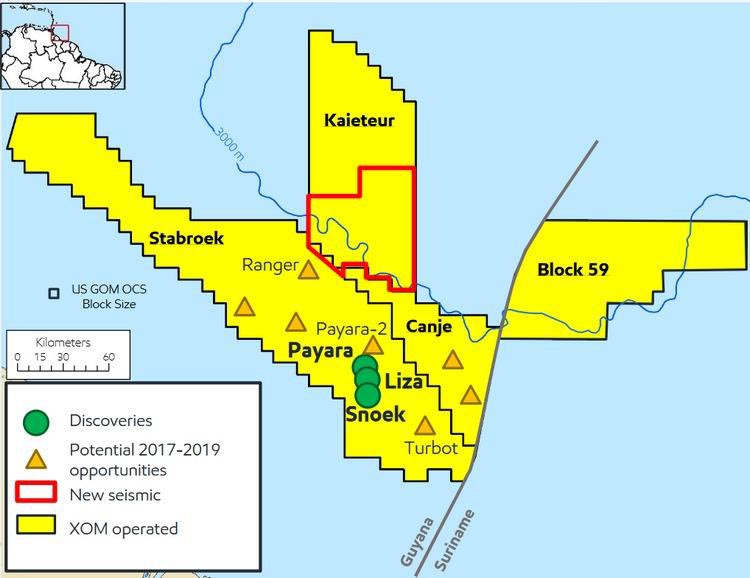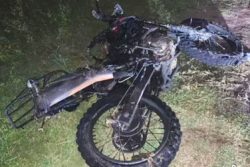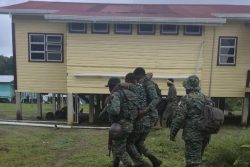Government and ExxonMobil yesterday announced a major oil discovery at the Ranger-1 well in the Stabroek Block, which is being called the largest single find since it began exploration offshore Guyana.
The finding of more than 230-ft of high-quality, oil bearing carbonate reservoir at the well is also the sixth discovery made by the company here since 2015, following previous “world-class discoveries” at the Liza, Payara, Snoek, Liza Deep and Turbot wells, which are estimated to total more than 3.2 billion recoverable oil-equivalent barrels.
As a result, government and Exxon’s local affiliate Esso Exploration and Production Guyana Limited (EEPGL), CNOOC Nexen Petroleum Guyana Limited and Hess Guyana Exploration Limited yesterday said they were pleased and gratified by the development
“This latest discovery represents the largest single find to date and adds to the quantities which have been confirmed in the five previous finds. The news of an additional find of this magnitude, particularly, at the start of the new year, can be seen as a further blessing and underscores the richness and diversity of Guyana’s natural resources. Managed prudently, these resources will allow for an enormous transformational effect on the lives of every Guyanese in the years ahead,” the Department of Public Information (DPI) said in a statement that was released yesterday morning.
ExxonMobil and Hess, respectively, made the same announcement on their websites.
“This latest success operating in Guyana’s significant water depths illustrates our ultra-deepwater and carbonate exploration capabilities,” said Steve Greenlee, president of ExxonMobil Exploration Company. “This discovery proves a new play concept for the 6.6 million acre Stabroek Block, and adds further value to our growing Guyana portfolio.”
EEPGL began drilling the Ranger-1 well on November 5th, 2017. It said the well was safely drilled to 21,161 feet (6,450 meters) depth in 8,973 feet (2,735 meters) of water.
Following completion of the Ranger-1 well, Exxon said that the Stena Carron drillship will move to the Pacora prospect, 4 miles from the Payara discovery. Additional exploration drilling is planned on the Stabroek Block for 2018, including potential appraisal drilling at the Ranger site.
Stabroek News on Monday last had reported that from preliminary tests, the Ranger-1 well showed promise to yield better results than the other wells where commercial oil discoveries were made thus far.
“Ranger-1 has carbonate play meaning it has a carbonate reservoir feature and from preliminary interpretation of that exploration it has so far showed positive porosity for oil and gas… so, yes, the prelims are indeed better than at the other wells,” a source had told Stabroek News.
According to the DPI statement, the government is elated that Esso Exploration/CNOOC/Hess remain ahead of their exploration schedule for the entire Stabroek block. It added that the Natural Resources Ministry expects that other international operators will draw confidence from their presence and the six finds made so far and would diligently pursue their own exploratory work programmes. Several companies have advanced their seismic data collection and are expected to drill in 2018, it further noted. It did not identify the companies.
The government also used the occasion to call on all stakeholders to act responsibly and patriotically as Guyana continues its thrust into the new sector and as news and events continue to unfold about the extent of the oil reserves offshore and the manifold opportunities and benefits for the Guyanese people.
It further reiterated its commitment to all efforts for the safe and efficient development of the offshore Guyana basin.
According to Exxon’s project overview of works in the Stabroek Block, the Liza-1 well discovery was announced in May, 2015 following drilling. The Liza-2 well was drilled and tested in July, 2016, while the Liza-3 well was drilled in October, 2016, confirming a world-class resource discovery in excess of 1 billion oil-equivalent barrels. (Appraisal drilling at Liza-3 identified an additional high quality deeper reservoir directly below the Liza field, which is estimated to contain resources between 100 and 150 million oil-equivalent barrels.) The Liza-4 well was drilled in March, 2017 and more than 197 feet of high-quality, oil-bearing sandstone reservoirs, which will underpin a potential Liza Phase 2 development were encountered.
The Payara-1 well discovery was announced in January, 2017. Payara was drilled in a new reservoir, where more than 95 feet of high quality, oil bearing sandstone reservoirs were encountered.
The Payara-2 well discovery was announced in July, 2017 and the company explained that Payara-2 encountered 59 feet (18 meters) of high-quality, oil-bearing sandstone reservoirs, with its discovery estimated at approximately 500 million oil-equivalent barrels.
Following its Liza and Payara finds, Exxon announced an oil discovery at its Snoek-1 well in March, 2017. The company says it encountered more than 82 feet of high quality, oil bearing sandstone reservoirs.
Exploration of the Turbot well followed Payara and in October of last year 75 feet (23 meters) of high-quality, oil-bearing sandstone reservoirs were encountered.










